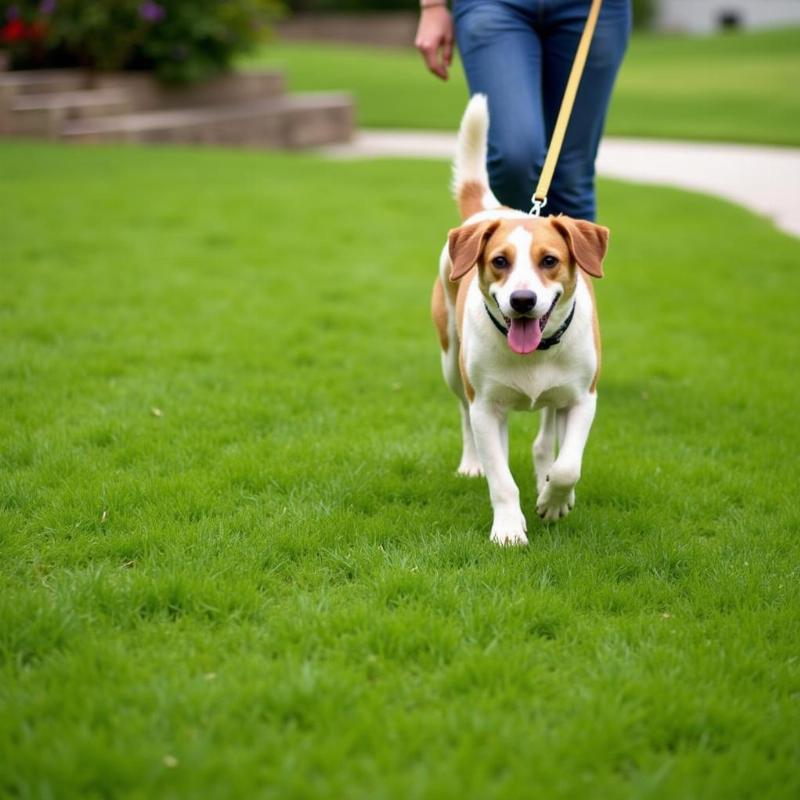Fertilizer is essential for a lush, green lawn, but it poses a significant risk to our canine companions. Understanding how long until fertilizer is safe for dogs is crucial for responsible pet ownership. This article dives into the critical waiting periods, potential dangers, and safety precautions you need to take to protect your furry friend.
Understanding the Dangers of Fertilizer
Fertilizers, while beneficial for plants, contain a cocktail of chemicals that can be harmful to dogs, ranging from mild skin irritation to severe poisoning. Ingestion of fertilizer granules, licking paws after walking on a recently treated lawn, or even inhaling fertilizer dust can expose your dog to these harmful substances. Common ingredients like nitrogen, phosphorus, and potassium, while essential for plant growth, can cause gastrointestinal upset, vomiting, and diarrhea in dogs. Some fertilizers also contain herbicides and insecticides, which pose even more significant risks, potentially leading to neurological problems, seizures, and even death.
How Long Should You Wait Before Letting Your Dog on Fertilized Grass?
The waiting period before allowing your dog on fertilized grass varies depending on the type of fertilizer used. Generally, it’s best to err on the side of caution. For granular fertilizers, waiting 24-72 hours is typically recommended. However, some fertilizers, particularly those containing herbicides or insecticides, may require a significantly longer waiting period, sometimes up to several weeks. Always carefully read and follow the manufacturer’s instructions on the product label. These instructions will provide specific waiting periods based on the product’s composition and potential risks.
Tips for Keeping Your Dog Safe After Fertilizing
Protecting your dog from fertilizer requires proactive measures. Watering your lawn thoroughly after applying granular fertilizer helps dissolve the granules and dilute their concentration, minimizing the risk of ingestion. Keep your dog leashed and supervised when in areas where fertilizer has been applied. This prevents them from rolling around or digging in the treated areas. Consider using organic or pet-safe fertilizer options, which are formulated with natural ingredients and pose less risk to animals.
 Dog walking on grass
Dog walking on grass
Identifying Signs of Fertilizer Poisoning in Dogs
Be vigilant for any signs of fertilizer poisoning in your dog. Symptoms can range from drooling, vomiting, and diarrhea to more severe signs like tremors, seizures, difficulty breathing, and lethargy. If you suspect your dog has ingested fertilizer or is exhibiting any of these symptoms, contact your veterinarian or the ASPCA Animal Poison Control Center immediately. Prompt veterinary attention is crucial in managing fertilizer poisoning and ensuring your dog’s recovery.
Alternatives to Chemical Fertilizers
Consider using pet-safe alternatives to traditional chemical fertilizers. Compost, seaweed, and manure are excellent natural options that enrich the soil without posing a threat to your furry friend. These organic options promote healthy lawn growth while minimizing the risk of chemical exposure.
Conclusion
Protecting your dog from the potential dangers of fertilizer requires vigilance and proactive measures. Understanding the risks, adhering to waiting periods, and choosing pet-safe alternatives are essential steps in ensuring your dog’s safety and well-being. By following the guidelines outlined in this article, you can maintain a beautiful lawn while keeping your canine companion safe and healthy. Remember, a lush green lawn shouldn’t come at the expense of your furry friend’s health.
FAQ
- What should I do if my dog eats fertilizer? Contact your veterinarian or the ASPCA Animal Poison Control Center immediately.
- Are all fertilizers harmful to dogs? While most synthetic fertilizers pose some risk, organic and pet-safe options are available.
- How can I tell if my fertilizer is safe for pets? Carefully read the product label for specific instructions and warnings regarding pet safety.
- Can fertilizer burn my dog’s paws? Yes, some fertilizers can cause chemical burns or irritation to a dog’s paws.
- How often should I fertilize my lawn? Fertilizing frequency depends on your lawn’s needs and the type of fertilizer used. Consult a lawn care professional for guidance.
- What are some signs of fertilizer poisoning in dogs? Vomiting, diarrhea, drooling, lethargy, tremors, seizures, and difficulty breathing.
- Is it safe to let my dog play on the lawn after it rains following fertilization? Even after rain, it’s best to follow the recommended waiting period specified on the fertilizer label.
Related Articles
- weed and feed that is safe for dogs
- is lime fertilizer bad for dogs
- can dog go on grass after fertilizer
- can dogs go on fertilized grass
Beautdogs.us is your premier source for expert advice on dog breeds, care, and lifestyle in the United States. We offer comprehensive and trustworthy information for both novice and experienced dog owners, helping you navigate the joys and responsibilities of canine companionship. From breed-specific guides to essential care tips, Beautdogs.us is your one-stop destination for all things dog-related. Contact us at [email protected] or +1 501-555-7529.